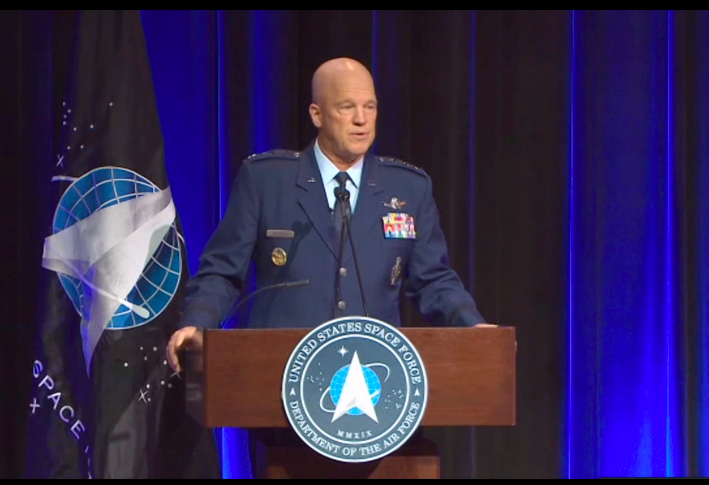
Gen. Jay Raymond
UPDATED to include Joint Staff explanation on UCP. WASHINGTON: Slashing the byzantine tangle of Pentagon oversight that has traditionally weighted development and procurement of space systems is next on the agenda of Space Force chief Gen. Jay Raymond.
“Now we’re gonna go after that bureaucracy,” he told the Air Force Association’s annual Air, Space and Cyber conference (AFA 2020, being held virtually) today.
Raymond restated that some 65 organizations now have roles in space acquisition, and “close to 30 have a role in force design” of space systems. His goal is to radically redo that structure, with an emphasis on streamlining acquisition.
“We must bring unity of effort across the department. We must reduce duplication of effort. We must slash costs, all while increasing our speed,” he said.
In an op-ed published in Defense News yesterday, Raymond explained that these changes will be included in a new Space Planning Guidance that he characterized as “our strategic roadmap.” The guidance also will create a new “Technology and Innovation Office” to push rapid development of new capabilities.
Raymond said that as a first step, the Space Force has delegated contracting authority “down from the Pentagon staff to acquisition experts in the field.” This will speed decision-making and ease interactions with industry, he said, but is just the beginning of a wider reform effort.
“This is just the first of a number of changes coming so that we can design and build and field capabilities at tactically relevant timelines,” Raymond said. “If we get this right, we will be the envy of the other services, because we’re not tied to business of the past.”
As Breaking D readers know, the Air Force and DoD have proposed a series of sweeping changes to space acquisition in a draft report to Congress that has languished at the White House Office of Management and Budget for months. The report was due to Congress on March 30, and a draft was sent to the Hill in May only to be hastily withdrawn.
As drafted, the Air Force report contained three recommendations that would require legislative action, and six that could be taken internally by DoD and the service. Some of the draft proposals have raised eyebrows, such as the suggested change to the current, congressionally-mandated budget structure that would allow acquisition authorities the ability to pool the budgets for a number of current programs into fungible spending pots. Further, the Air Force has been dragging its collective feet on Congress’s order in the 2020 National Defense Authorization Act to create a new Space Acquisition Executive independent from the office of Air Force acquisition czar Will Roper.
Reiterating the mantra from top DoD leaders in promoting the Space Force over the past months, Raymond said that the need to speed space systems development and acquisition is to stay ahead of growing threats from Russian and China.
“We are on the cusp of a tectonic shift in warfare; access to space can no longer be assumed,” he said. “We need to build for the future.”
Raymond explained that the first priority for Space Force is to “protect what we have on orbit today.” Next, he said, the service must implement changes to “bridge to a new force design — a warfighting architecture able to meet the threat, while reducing first mover advantage. And third, we must have the ability to punch back.”
“The Unified Command Plan is clear: US Space Command commander must have the independent options through and from space to ensure freedom of action in all domains,” he added.
Space Command was stood up in August 2019 as a ‘geographic’ command that is in charge of its own theater of operations.
UPDATE BEGINS. A spokesperson for the Joint Staff explained in an email today that Raymond was referring to the UCP signed in May 2019, which laid out roles and missions for Space Command, following President Donald Trump’s December 2018 decision to reinstate it. Joint Chiefs Chairman Gen. Mark Milley is currently reviewing revisions to the UCP that will further flesh out command relationships. UPDATE ENDS.
“And finally, we must identify new missions that should be conducted from space,” Raymond said.
An example, he noted, is tactical-level intelligence, surveillance and reconnaissance (ISR) from space — something that a multitude of Pentagon agencies, from Space Force to DARPA to the Space Development Agency (SDA) are exploring via the use of Low Earth Orbit (LEO) satellites in large constellations. (As Breaking D readers know, many Space Force leaders also have been talking about a military move to cislunar space.)
Raymond’s articulation of Space Force’s priorities is intriguing, because as a number of DoD sources and outside experts have pointed out, the order of those priorities up to now have not been specified in documents such as the new capstone doctrine document on “Spacepower.”
Crucially, these sources say, Space Force and DoD leaders have yet to formally clarify to what extent the new service should focus on its legacy role of ensuring the resiliency of the US space architecture and protection of US systems or on the new “warfighting” role that would involve seriously beefed up offensive capabilities. Indeed, as Breaking D readers know, Space Force leaders seem to emphasize one over the other in their rhetoric depending on their audience.
Thus, perhaps Raymond’s statement is a harbinger of more formal moves — either in planning and doctrine documents or in the 2022 budget request. Watch this space.
From F-16s to NATO, Argentina’s moves tilt West, but ties to China to last
There are flashpoints to watch as Argentina navigates its future between the polar attractions of Washington and Beijing, including future defense deals and a deep space facility.


























